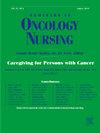妇科癌症相关下肢淋巴水肿的预防和管理干预措施:系统性范围界定综述。
IF 2.3
4区 医学
Q1 NURSING
引用次数: 0
摘要
目的:本综述旨在为减少妇科癌症手术后下肢淋巴水肿发生率和症状的干预措施提供证据。方法:本次范围审查遵循乔安娜布里格斯研究所方法手册概述的方法和方案。2024年1月检索Pubmed、Scopus、Web of Science、CINAHL、PsycINFO等5个数据库。结果:本综述包括15项干预措施,主要用于预防和管理癌症相关的下肢淋巴水肿。大多数研究都考察了干预措施对淋巴水肿相关症状发展和生活质量的影响。大多数研究测试了复杂的减充血疗法(CDT) (n = 6,39.9%),包括各种技术,如手动淋巴引流,压迫,运动和皮肤护理。在这些干预措施中,86.6%至少改善了一项结果测量,如生活质量、淋巴水肿发生率、症状和下肢体积。结论:有限的证据表明,干预措施的使用似乎有可能降低淋巴水肿的风险和症状,并改善接受妇科癌症治疗的妇女的生活质量。对护理实践的启示:在护理实践中开发和测试全面的淋巴水肿教育和管理策略对于优化患者预后和提高接受妇科癌症治疗的妇女的生活质量至关重要。本文章由计算机程序翻译,如有差异,请以英文原文为准。
Interventions for Prevention and Management of Gynecological Cancer-Related Lower Limb Lymphedema: A Systematic Scoping Review
Objectives
This scoping review aims to map out evidence on interventions for reducing lower limb lymphedema incidence and symptoms after gynecological cancer surgery.
Methods
This scoping review followed the methods and protocol outlined by the Joanna Briggs Institute Methods Manual. Five databases, including Pubmed, Scopus, Web of Science, CINAHL, and PsycINFO were searched in January 2024.
Results
The review included 15 interventions primarily designed to prevent and manage cancer-related lower extremity lymphedema. Most studies have examined the effect of interventions on the development of lymphedema-related symptoms and quality of life. Most studies tested complex decongestive therapy (CDT) (n = 6, 39.9%), including various techniques, such as manual lymphatic drainage, compression, exercise, and skincare. Of the interventions, 86.6% improved at least one outcome measurement, such as quality of life, lymphedema incidence, symptoms, and lower limb volume.
Conclusions
Limited evidence shows that the use of interventions appears to have the potential to reduce the risk and symptoms of lymphedema and improve the quality of life in women undergoing gynecological cancer treatment.
Implications for Nursing Practice
Developing and testing comprehensive lymphedema education and management strategies in nursing practice is essential to optimize patient outcomes and enhance the quality of life for women undergoing gynecological cancer treatment.
求助全文
通过发布文献求助,成功后即可免费获取论文全文。
去求助
来源期刊

Seminars in Oncology Nursing
Nursing-Oncology (nursing)
CiteScore
3.40
自引率
0.00%
发文量
68
审稿时长
45 days
期刊介绍:
Seminars in Oncology Nursing is a unique international journal published six times a year. Each issue offers a multi-faceted overview of a single cancer topic from a selection of expert review articles and disseminates oncology nursing research relevant to patient care, nursing education, management, and policy development.
 求助内容:
求助内容: 应助结果提醒方式:
应助结果提醒方式:


